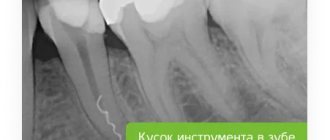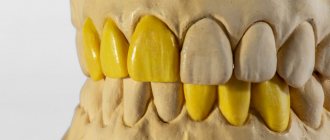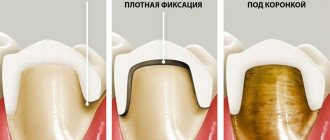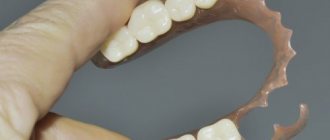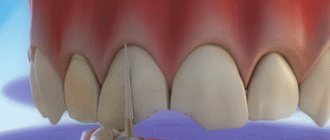At their core, crowns are dentures made in such a way that they are almost impossible to distinguish from real teeth. With the help of crowns, both one tooth and several nearby missing ones are restored.
The search for the optimal material for making dentures has led to the fact that dentists now offer a large number of them to choose from. But how can the average person navigate this diversity and choose the best dental crown? Specialists at the AcademyDENT clinic will try to answer this question. On our website you can see in the photo what a crown on a tooth made of different materials looks like.
When are dental crowns needed?
Dentists have identified the following indications for the installation of this type of prosthesis:
- Destruction of the crown part of the tooth by more than 50%. Most often, this situation occurs with severe caries or with injuries. In this case, a crown is installed to protect the tooth from further destruction.
- Protection of pulpless teeth. Removing a nerve from a dental canal is accompanied by a weakening of the enamel - it becomes fragile, so it is quite advisable to protect it with a crown.
- Any aesthetic defects: tetracycline teeth, fluorosis.
By contacting the AcademyDENT clinic, you are guaranteed to receive a qualified consultation with a doctor who will tell you exactly whether you need a dental crown or whether other treatment methods are possible.
Application of composite reinforced (FRC) bridges as immediate structures
A fairly large and pressing problem that both the patient and the doctor now face is the choice of an appropriate treatment method in all the available diversity. One area where there is a continued increase in treatment options is the replacement of a single missing tooth in the anterior segment. After making a diagnosis and obtaining informed consent, the dentist’s task is to familiarize the patient with all possible treatment options for his pathology.
Such discussion should include application issues:
Dentures: Immediate vs. delayed dentures, acrylic and cobalt chrome vs. flexible acrylic, with the pros and cons of each. The prognosis for the success of treatment, aspects of oral hygiene, the use of a specific design of the structure, the available space for the chosen prosthesis, and more should be touched upon. The production of plate dentures remains a very fast, cheap and least invasive way to restore the dentition. That is why it continues to be a very likely treatment option.
Adhesive bridges with metal wing-shaped fixation: this option is an excellent choice and is still relevant in modern dentistry. Studies have determined that careful attention to occlusal loading and avoidance of unnecessary contact can provide a good prognosis for retention. It is very difficult to produce these structures immediately, and the traditional design does not always pay off, however, this type of prosthesis should not be overlooked.
Conventional metal bridges with ceramic lining can function either as a bilateral support or as a cantilever. The positive features of this design have made it popular for decades, and when it is made correctly, its performance remains excellent. Their reputation was tarnished by the Saunders study in 1990, which showed the impact of full crown preparation on the dental pulp tissue, as well as the high "biological cost" of all treatment options available today. It is very difficult to justify their use on minimally damaged or intact abutment teeth, or with previously treated root canals. They often have a short lifespan and must be placed a considerable time after surgery, which means the use of temporary structures over several months. For me, the saying “when a bridge breaks, it takes another tooth with it” remains true, so patients should be well informed before treatment.
Crowns installed on an implant are currently the “gold standard” for replacing defects in the anterior segment, which is why this area of dentistry is one of the most promising. Such a system is a free-standing unit that does not in any way depend on or damage the adjacent tooth. An artificial tooth installed in this way looks and feels like your own, while the procedure is highly predictable and has a long service life. But all the benefits are reflected in the price and duration of treatment. It should also be taken into account that no structure can last forever and holding a conversation on the topic of the service life of the structure is a necessity.
A review of the literature on the survival rate of such implants is beyond the scope of this study, however, taking into account the data of Torabinajad and Iqbal, the survival rate is comparable to that of endodontically treated teeth. Doyle determined a survival rate of 96%, but also identified the need for postoperative treatment 5 times more often. All this indicates that there is no need to rush to remove teeth to make room for implants, the situation should be considered taking into account the health of the gums, and not just the automatic replacement of the dentition. It should also be taken into account that, despite the long-term study of the problems of periodontology, we still cannot operate with reliable facts about peri-implantitis. Therefore, when assessing the likely life of such a structure, extreme care and attention must be exercised, as in all other areas of restorative dentistry.
The information described above is not intended to be a comprehensive overview of the pros and cons of each treatment option, but merely to illustrate the extensive discussion required when replacing a missing tooth. All decisions and discussions must be made only together with the patient. It is very difficult to predict the service life of any of the structures, however, any fixed prosthesis is usually limited to a cycle of 10-15 years, after which it needs to be replaced.
In recent years, the list of possible solutions has been expanding, and therefore, reinforced composite bridge-like imidiate prostheses, used in both direct and indirect manufacturing, are also coming into view. They can have a two-tooth support design, as well as a cantilever design, as well as part of an aesthetic periodontal plate, used in situations where one or more teeth are missing.
Structure and design
Composite reinforced structures are, of course, not new and their previous use has led to very different results. Many dentists and patients remember the less than successful use of Targis Vectris (Ivoclar), and a Turku Finland study found success in less than 50% of cases. A common problem with all early systems was delamination of the composite, which was essentially eliminated in everStick, which uses a patented InterPenetrating Network (IPN) technique that provides enhanced bonding of the material.
A more recent study by Mannocci described IPN as a combination of two polymers of different shapes. Most IPNs include one rubber phase and one glassy phase. In the case of the Stick products described here, a semi-IPN polymer is used with a glass fiber sealant impregnated with an IPN matrix. EverStick FRC consists of polymethyl methacrylate as the spacer phase and polybis-GMA as the cross-phase polymer matrix. When everStick products and the bonding agent come into contact, the bonding monomer penetrates into the spacer phase of the IPN polymer matrix and upon subsequent polymerization, the two components create a strong bond.
Improvements of this kind have led to improved results recorded by Professor Ozcan of the University of Zurich, reporting a success rate of 95.2% over 6 years. The main advantage of FRC bridges is the minimal adjustment of adjacent teeth, as well as the ability to place the wings buccally, which is not possible with a metal bridge. Also, such dentures have a positive effect in case of extensive damage to periodontal tissues, violation of the integrity of supporting teeth, and also when making impressions is difficult. The immediate prosthesis works great in case of injury, as well as in emergency cases when there is no time to complete the laboratory steps. However, if aesthetics are a high priority, indirect bridge structures should be made.
The clinical cases described below represent situations in which the use of these prostheses is possible, and they also describe the usual treatment protocol with StoneRock. Before the start of each treatment, a long discussion was held with the patient, indicating all the pros and cons of the chosen technique, as well as providing information about alternative treatment methods.
The basis of any successful FRC bridge application is careful and quality fiberglass fabrication, taking into account the occlusal load and space required for esthetic placement of the composite. There is a clear lack of research on the design of such prostheses, but what was certain in the author's cases was the high success rate of horizontal fiberglass placement in the buccal position. According to the author’s experience, vertical fiberglass can also be additionally installed in cases where the composite needs to be positioned more than 2 mm beyond the boundary of the horizontal fibers. When working on the upper jaw, it is better to lay vertical fibers somewhat palatally to the horizontal ones in order to limit the acting forces, while for the lower jaw it is better to use the opposite technique. An additional advantage can be gained by laying additional fiberglass perpendicular to the main one (Photo 1). Research by Dr. Dyer, who studied the effect of the position of glass fibers, concluded that fibers placed on the compression side and the tension side provide the highest resistance to fracture.
Photo 1 shows wide horizontal fibers curved buccally with vertical fibers on the compression side to reduce tensile forces. Note that the central incisors are restored with labial porcelain veneers, leaving the palatal surface intact for standard adhesive techniques. EverStick fibers with a thickness of 1.5 mm (4000 glass strands) are ideal for horizontal elements, while everStick Perio Fibers 1.2 mm (2000 glass strands) are ideal for vertical elements. As a word of warning about the design, in rare cases more than two fibers (one vertical and one horizontal) are required to restore one front tooth.
The decision to follow a cantilever or two-abutment design is made based on personal preference, oral situation, occlusal factors, and prognosis of the abutment teeth. The high flexibility of FRC bridges allows the use of a two-abutment design without increasing the load, which is especially important in periodontal disease.
The indirect approach bonding technique is relatively standard and is performed using a conventional protocol with the addition of one step. Indirect FRC bridges made from everStick require a minimum of five minutes of soaking in a StickResin solution. This solution is designed to maximize the effect of IPN by partially dissolving the PMMA around the fiber fiber, which then promotes bridging, thereby increasing the overall level of adhesion.
The bonding protocol for direct FRC bridge manufacturing requires the same steps as the indirect method, with the exception of the StickResin step, since the fibers are not in a cured state, which means their bonding potential is already at its maximum.
Bonding protocol for direct FRC bridge
1. Rubberdam
2. Removal of existing restoration
3. Abrasive treatment of all areas subject to bonding
4. Three-stage etching, application of primer and adhesive using Optibond Fl
5. The flowable composite is applied but left uncured.
6. Fibers are placed in an uncured flowable composite and positioned to the desired position
7. 40 second cure
8. Application of a fluid composite over all surfaces of the fibers
9. Aesthetic layering of composite to achieve the final restoration
There are a wide variety of composites to choose from, but the author has determined that G-aenial Universal Flo (GC Corp, Japan) opaque shades offer high strength, ease of application, and inhibition of fiber show-through. It should also be noted that the radiopacity of GC products is approximately equal to dentin and therefore does not provide much contrast on a radiograph. Fiberglass is completely x-ray permeable, so cement and composite should be used with it. Complete coverage of the fibers is desirable as residual fragments can contribute to plaque accumulation, although plaque has not been shown to be a problem with everStick.
Clinical cases
Case 1: Direct FRC Bridge Recovery
This patient avoided any prosthetics for many years; he did not want to install implants, wear dentures, and also did not want to screw in abutments.
Photo 1: Smile before treatment
Photo 2: Horizontal fibers secured with flowable composite
Photo 3: Vertical fibers are attached to horizontal fibers using a flowable composite
Photo 4: Smile after treatment
Case 2: Direct immediate bridge
Figure 1: Spot X-ray of the maxillary incisors shows extensive decay and apical pathology near the maxillary right central incisor.
Photo 2: Color photo showing the crown of the upper right central incisor described above
Photo 3: The tooth is removed, the restoration from the upper left incisor is also removed. The vestibular surface of the tooth is formed as part of the prosthesis. In this situation, the prosthesis design can be formed directly with the rubber dam, since it provides an excellent matrix.
Photo 4: Making a straight bridge using fiberglass, as shown in example 1
Photo 5: Manufactured immediate bridge
Photo 6: Examination after 6 months, application of gum shade composite at 3 months
Photo 7: Photograph of the oral cavity after 6 months
Figure 8: Occlusal view of the dentition showing the thickness of the structure
Case 3: Immidiat-bridge indirectly
In this case, the upper left lateral incisor was small and significantly mobile, which meant careful selection of the width of the structure. Vestibular veneers were included in the design of the prosthesis.
Photo 1: Close-up view of the upper left lateral incisor with complete root resorption.
Photo 2: Snapshot showing immediate emergency recovery
Photo 3: Three-unit indirect imidiate prosthesis
Photo 4: Follow-up after 1 year
Case 4: Multiple abutments
In this clinical case, the patient lost all 4 front incisors due to periodontal disease 2 days before Christmas. A direct immediate prosthesis was urgently installed with a delay in the decision regarding its treatment. An FRC bridge was placed to minimize the impact on adjacent teeth.
Photo 1: Installed rubber dam. Before conventional etching, pigmented dentin is removed with an abrasive.
Photo 2: U-shaped fibers and preliminary modeling
Photo 3: Vestibular and lingual placement of fibers
Photo 4: Second stage of modeling
Photo 5: Final view of the bridge showing satisfactory aesthetics. Improved appearance can be achieved by applying different shades from the cutting edge to the gum, as well as accentuation of anatomical lines
Photo 6: View of the imidiate bridge in the oral cavity
Conclusion
Composite reinforced bridges provide good fixation, aesthetics and minimally invasive intervention, which can be a worthy alternative to standard techniques. Information on long-term results beyond 6 years is not yet available, and patients should be warned that minor restorative adjustments may sometimes be required to maintain appearance. Also, these structures are easily stained, which the patient should also be informed about. You should also be aware of hygiene standards.
Author: Ian Kerr, BDS, Member of the British Endodontic Society and British Society of Restorative Dentistry StoneRock Dental Care, Kent, UK
Contraindications
It is not possible to install a crown on every tooth - there are certain situations when the feasibility of its installation is highly questionable. Contraindications include:
- pathological tooth mobility;
- insufficient height of the tooth crown - in this case the prosthesis will sink;
- chronic inflammatory processes in the mouth;
- unfilled canals of the prosthetic tooth.
At AcademyDENT, doctors carefully follow all indications and contraindications for prosthetics, so we have an extremely low percentage of complications.
Advantages of prosthetics at EspaDent
To ensure a reliable dental crown installation, a dental office with a chair and a bright sign are not enough. The clinic must have its own dental laboratory, as well as technological equipment. This will ensure fast and high-quality production of the prosthesis, and will also allow you to choose a more modern design.
The qualifications of doctors are confirmed by certificates, length of service and similar experience.
Specialists at EspaDent clinics have over 10 years of specialized experience and annually undergo training in international centers in Europe and the USA. The qualifications of our doctors are confirmed by the presence of the necessary certificates.
The treatment method in our clinics is selected individually for each patient, taking into account his personal preferences and capabilities. The initial examination, which is carried out free of charge, also includes hardware diagnostics with X-ray examination. For a more accurate diagnosis, specialists at EspaDent clinics use a modern 3D tomograph, which allows obtaining three-dimensional, layer-by-layer images of both jaws.
We don't like loud slogans and intrusive advertising. Our new clients are those who came based on recommendations from our patients. Because the patient’s health is the most important thing for us.
Ceramic crown
Ceramics is the most suitable substance for making teeth, since in its composition and structure it is very close to tooth enamel. Ceramic crowns are an ideal option for prosthetic restoration of anterior teeth, as they provide the most effective aesthetic replacement.
So the advantages:
- excellent aesthetic effect;
- excellent prosthetics for both frontal and chewing teeth;
- resistant to dyes.
E-max glass-ceramic crown prostheses are becoming increasingly popular.
Advantages of fiberglass pins
During fixation, the fiberglass pin does not need to be treated chemically, and there is no need to use specific “branded” materials. Fixation is possible using any conventional adhesive technique and composite materials - the pin is simply fixed in the root canal.
Such pins have excellent aesthetic characteristics - their color is close to the shade of natural tissues, so they are used, among other things, to restore front teeth. The material is easy to process. Using a diamond tool, the shape and length of the product can be adjusted. Light-curing composite materials are used to model the stump part of the structure.
Metal crown
Dentures began to be made from metal almost 100 years ago. Initially, preference was given to gold - crowns were made from it quite simply, but were too soft. Gradually, a special gold-based alloy began to be used for crowns - the addition of other metals makes it possible to achieve high strength of the product.
Nowadays, dentists use not only precious metals (gold and silver) to make crowns, but also “base” metals: titanium and steel. All metal crowns have a rather low aesthetic quality - the presence of gold teeth in the mouth currently does not make a person beautiful. In addition, the cost of such products is actually not considered one of the lowest.
Care after installation
Caring for dentures is practically no different from caring for “natural” dentures and includes the following steps:
- daily brushing of teeth and tongue twice a day (morning and evening);
- regular cleaning of the space under dentures and interdental spaces (it is recommended to use an irrigator and dental floss for these purposes);
- exclusion of too hard foods from the diet, proper nutrition, avoidance of sudden temperature changes;
- using mouth rinses after every meal;
- control of gum condition.
In addition, many dentists advise that after dental prosthetics with crowns, regularly massage the gums underneath them to stimulate blood circulation and normalize local metabolic processes. You need to massage your gums in smooth circular movements counterclockwise and clockwise.
In Moscow, you can install dentures at a dental clinic. You can make an appointment for the procedure of dental prosthetics with crowns by filling out a simple online form on the website or by calling.
Metal-ceramic crown
In search of a compromise between the unaesthetic appearance of metal and the insufficient strength of ceramics, dentists developed metal-ceramic dental crowns. During their manufacture, a ceramic coating is applied to a metal base, masking the metal, while the metal base provides sufficient strength and rigidity. The advantages of such structures include:
- reasonable cost;
- natural appearance;
- strength comparable to conventional metal prostheses.
Disadvantage: when the gum recedes, the metal part of the crown appears from under it, which reduces its aesthetic value.
What is ceramic composite
Keromer for medical purposes is a material that has only the best qualities of the substances included in its composition and is devoid of their disadvantages. The material is used to create crowns, veneers, bridge systems and onlays. The main feature of the material is that it consists not only of basic substances, but also has impurities.
It is due to such mixed materials that crowns and dentures made from this substance are most reliable. High-quality material must necessarily contain particles of ceramics, which are used to create dentures and crowns. Otherwise, the admixtures added are extremely varied and depend on the type of ceramic composite.
Metal composite crowns
Another attempt to combine metals and non-metals in dental crowns is metal composite crowns. Their peculiarity lies in the manufacturing method - a light-curing composite is applied to a metal base. A new tooth is formed, similar to a real one. Such dental crowns are very attractive from an aesthetic point of view; they look very good both in place of the front teeth and in the place of chewing teeth.
But there are more disadvantages than advantages.
Composite crowns: average in price, but not in quality
So, you need to get dentures. The dentist said that a crown or bridge is required. The choice was also provided: a metal, metal-ceramic crown, a zirconium dioxide crown or metal-free ceramics. You brushed aside the metal one right away - you want the new tooth to look inconspicuous. Have you already thought about which crowns are best to install:
| Price (average for the Moscow region) for 1 crown | Advantages | Flaws | |
| Metal ceramics | 4-7 thousand rubles | Durable classic | There is no transparency inherent in “natural” teeth Serious treatment of the tooth before installation |
| Metal-free ceramics | 12-16 thousand rubles | Perfect aesthetics | fragile |
| Zirconium dioxide | 20-25 thousand rubles | Strength of metal ceramics + aesthetics of metal-free ceramics | Significant cost |
Are there crowns that would cost less than metal-free ceramics, but would perfectly match the tone of natural teeth and remain strong?
Composite crowns and bridges meet these requirements. If you want a more favorable price solution compared to metal-free ceramics and especially zirconium dioxide, then a composite tooth crown is the optimal solution for you.
Plastic dental crowns
Dental crowns made from plastic are the cheapest option of all types of dental crowns. They are made the fastest and easiest, the cost of material for them is the lowest. Most often, temporary crowns are made from plastic and placed on patients while permanent crowns are made from a different material.
Pros:
- fast production;
- ease of installation;
- cheapness.
Flaws:
- wear out quickly - service life does not exceed 2 years;
- low strength - it is not recommended to install them on chewing teeth;
- low aesthetic value.
Features of fiberglass pins
- High strength (1000 MPa), comparable to titanium.
- The elastic modulus of 35 GPa is close to that of natural dentin.
Thanks to a natural combination with hard tissues and modern composite materials for fixation, such pins are characterized by a long service life and high strength. Another reason for this is the uniform distribution of the chewing load throughout the entire tooth root. Due to the elasticity of the fiberglass pin, comparable to tooth tissue, the risk of mechanical destruction is minimal.
The main stages of installing a crown on a tooth
The process of prosthetics of the crown part of the tooth occurs in several stages:
- Diagnostics - a preliminary assessment of the condition of all teeth in the oral cavity is performed. To do this, a thorough dental examination is carried out, during which the amount of treatment required is assessed.
- Treatment - all carious teeth are treated, if necessary, depulpation of the target tooth is carried out with filling of the canals.
- Tooth grinding - tools are used to model the tooth for a crown. If the dental tissue is preserved in sufficient volume. then a simple grinding is performed, but if the tooth is too damaged, then a special inlay is installed.
- Taking impressions - these are necessary to make an anatomically compatible crown shape.
- Making crowns - this process takes place in a dental laboratory, where a tooth model is made based on impressions, and a crown is made on its basis.
- Installation of crowns - they are fixed to the prepared tooth with special dental cements or composites that provide reliable fastening.
At DENT Academy, each of the above stages is carried out in strict compliance with international standards, which completely eliminates errors and inaccuracies during the process.
Who is suitable for composite crowns and bridges?
- For those who want a crown with the following properties: stronger than metal-free ceramics, but cheaper than zirconium dioxide - once; more aesthetically pleasing than metal ceramics, but cheaper than metal-free ceramics - two.
- Those who are missing one or more teeth;
- For those who have severely damaged teeth;
- For those who are allergic to metal;
- For those who do not have bruxism - night grinding of teeth. With constant jaw clenching, any crown covering will either crack or wear off over time. Therefore, for severe bruxism, two options are recommended - either facets or silicone aligners, which the patient will wear at night so that the new crowns last a long time.
What determines the cost of a dental crown?
The final cost of prosthetics is influenced by several important factors:
Pricing policy for a specific dentistry: All private clinics target a specific cohort of consumers with approximately the same level of income. Therefore, the cost of the same prosthesis can vary dramatically. DENT Academy does not offer the lowest prices - we offer very high-quality work at an adequate cost.
Cost of materials: It is logical that plastic dentures are much cheaper than zirconium dioxide, so when choosing a specific type of dental crown, you should focus on your financial capabilities. Our clinic specialists will help you choose the best option that combines high quality with an affordable price.
The clinic has its own dental laboratory: The technological process of making dentures is financially very expensive. If there is no laboratory, the clinic is forced to enter into an agreement with an independent laboratory. Naturally, the cost of such prostheses will increase, if only because of logistics costs.
Qualification of personnel: it is natural that when a doctor with extensive experience and work experience receives more money for it, accordingly, the cost of his work will be higher than that of a young specialist who has no experience and whose quality of work is unknown. The price of dentures also includes the cost of paying for the work of a dental technician, whose qualifications largely determine the quality of the manufactured crown, especially when it comes to high-tech structures.
What is a composite crown?
Composite crowns, like metal-ceramic crowns, consist of two components: a frame and a covering. The frame is made of hypoallergenic durable material of white or beige color, and is covered with a composite to match the color of the patient’s teeth. One of the most important advantages of a composite crown is that in the event of a chip (and chips can happen on any crown), it can be repaired in the doctor’s chair in 20 minutes. All other types of crowns must be removed from the mouth, taken to a dental technician and wait for repairs. Thanks to the light frame, composite crowns look natural. Like this:
The production time for a composite crown is the same as for a metal-ceramic crown. Unlike zirconium crowns, which are modeled by computer (which increases their cost and production time), we produce composite crowns in our dental laboratory. Here:
How and why dental crowns are removed
A well-made dental crown can be worn for decades, of course, if the material from which it is made is designed for this. However, standard recommendations are to replace it every 10 years or more frequently as required.
Premature removal is carried out when certain unpleasant symptoms appear, most often indicating incorrect installation. So, crown removal is carried out when the following symptoms appear:
Crown pain
Although modern techniques for working with materials make it possible to ensure a filigree match of the crown to the prepared tooth, sometimes situations arise that the patient complains of pain in the crown. Of course, it is not the tooth that hurts, but the tooth on which it is installed. Among the causes of pain, caries is the leading cause; less often, pain occurs with untreated roots.
Unpleasant smell
The appearance of a putrid odor may be due to the fact that food particles are packed under the crown. Due to the inability to remove them even with the help of high-quality teeth cleaning, they become contaminated with bacteria and decompose, which is accompanied by a putrid odor.
When installation is acceptable and when not
Indications for the use of ceramic composite for medical purposes are determined by the manufacture of dentures. The material is used to make artificial crowns of individual teeth. Dentures on implants and bridges for no more than 5 teeth are also made from the material. When placed, bridges require natural teeth or individual implants to support them.
In addition to indications, the material also has prohibitions on use. The first and most important is a ban for people with intolerance and allergic reactions to the components of the drug. Do not use the material if you have inflammatory and infectious gum diseases.
Children under 15 years of age are prohibited from using such material as an option for correcting the position of teeth. If you suffer from bruxism, it is also not allowed to install these types of crowns and dentures, since the material can cause additional problems. And another important contraindication is the installation of treatments for people who cannot provide proper oral care.
